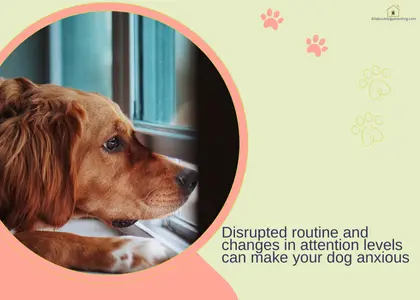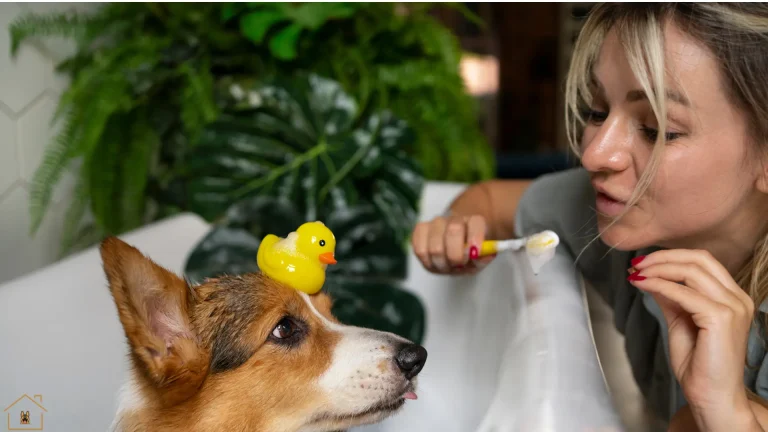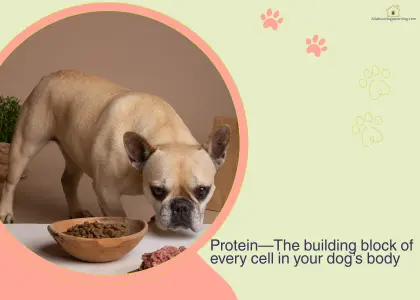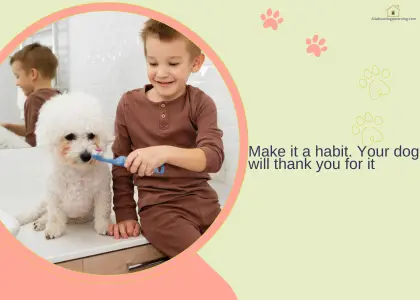Why Do Dogs Get Eye Boogers? Causes & Cleaning Tips
As a dog mom, I’m all too familiar with the crusty eye goop my pet often wakes up with. If you have a pet at home, I’m sure so are you. While it might look gross and you may not enjoy cleaning off dog eye boogers part of the grooming routine (I know, I don’t), this is usually normal, and typically, just an accumulation of tears and debris. Usually, but not always.
Sometimes, dog eye discharge can be the sign of an underlying infection or allergy. I discovered this when my GSD suddenly started having a discharge build-up around his eyes all the time. I’d clean him up, and his eyes would be surrounded by gunk in no time. Not only was the recurrence concerning, the appearance of the discharge felt different from the usual dog eye boogers. That was my cue to seek medical attention, and it turned out to be an eye infection.
You see, sometimes, something seemingly normal or usual can mask an underlying issue. That’s why I decided to put together this guide on dog eye discharge to help fellow pet parents. Let’s take a closer look at types of boogers, what causes them, the correct way of cleaning dog eyes, and when to see a vet.
What Are Dog Eye Boogers?
What are eye boogers in dogs? It is simply the discharge that collects in the corners of a dog’s eyes, and typically constitutes a mix of dried tears, oils, mucus, and dust. A small amount of clear or pale discharge, especially after sleep, is normal tear drainage.
However, the look of the discharge matters. Clear, watery tears usually mean nothing serious, whereas thick or colored mucus can indicate trouble. That’s a key normal vs abnormal eye discharge difference.
While clear, odorless discharge from your pet’s eyes is normal. You must see your vet if it turns milky white, green, or yellow, or causes your pet discomfort. Different dog eye discharge types can tell a different story.
—Dr. M Moniello, veterinarian
Common Causes of Eye Boogers in Dogs

Dogs can develop eye discharge for many different reasons, and not all of them are worrisome. Sometimes it’s simply normal tear drainage, while in other cases, irritants like dust or pollen are to blame. Infections and even breed-related traits can also play a role in how much gunk builds up around the eyes. Understanding the most common causes of dog eye boogers helps you know when it’s just routine and when it’s something more:
1, Normal Tear Drainage
Your dog’s eyes produce tears for lubrication and cleaning. A tiny bit of eye mucus or crust is just normal tear overflow. Dr. Moniello notes, “Dogs often get sleepies after dozing. This small amount of crust on waking is no big deal.” In fact, I don’t even pay much mind to small amounts of eye gunk on my GSD’s face. I just clean it up with a damp cloth as part of his daily grooming, and we both get on with our day.
2. Allergies or Irritants
Irritants can make any dog’s eyes water. Seasonal allergens like pollen and mold, dust, smoke or even strong household cleaners often trigger excess tearing. If your dog seems extra teary around pollen seasons or when you dust the house or use a perfume around them, environmental irritants are likely the culprit.
3. Eye Infections
An underlying infection is among the most common dog eye discharge reasons, especially if the discharge changes color or is thicker in consistency than usual. Dr. Jennifer Coates, DVM, notes, “A dog whose eyes produce yellow or green discharge often has an eye infection.” The infection can be bacterial, viral, or may stem from another issue like a scratch. Whatever the underlying cause, a visit to the vet is warranted.
4. Breed-Related Issues

Some breeds naturally accumulate more eye discharge. Flat-faced dogs like Pugs, Bulldogs, Shih Tzus have shallow sockets or facial folds that trap tears, so they get chronic tear stains and sticky goo. These brachycephalic pups are known to have extra eye goop by birth. In long-haired breeds like Maltese or Yorkshire Terriers also the debris can get trapped in the fur if it’s not trimmed regularly, and you may notice more than usual puppy eye discharge. Overall, face shape and grooming can affect how much dog eye boogers show up.
Symptoms That Require Vet Attention
While a little discharge can be part of everyday dog life, certain symptoms point to an underlying problem. Discharge that changes in color, comes with an odor, or shows up alongside redness and swelling are all warning signs. Dogs may also squint, paw at their eyes, or tear excessively when something is wrong. These dog eye health warning signs are your cue that it’s time to call the vet instead of waiting it out.
- Unusual Color or Odor
Watch for green, yellow or bloody discharge. These are the most common dog eye infection symptoms. Dr. Coates emphasizes, “Discolored eye gunk often has an eye infection, especially with redness. A foul smell from the eyes is also abnormal.” Even a slight yellow tint or any odor should raise concern, since infected eyes often produce sticky, odorous mucus. If you see these signs, don’t wait. Seek medical attention right way.
- Excessive Tearing or Squinting
In addition to abnormal dog eye discharge, pay attention to excessive tearing up or sudden squinting. Excess tear overflow means irritation, an allergy, or possibly a blockage. If your dog blinks rapidly, refuses light, or can’t fully open an eye, it could indicate pain or injury. Pet health guidelines warn that tearing so bad it stains the face or causes swelling should always be checked out.
- Accompanied by Other Symptoms
When you’re looking for dog eye health warning signs, you need to look beyond the boogers. Redness, swelling, or eye discharge along with sneezing, coughing, or fever can signal something more systemic. If your dog is pawing at its eye or the eye looks cloudy, seek veterinary care urgently.
Safe Ways to Clean Dog Eye Boogers

Cleaning your dog’s eyes needs care because eyes are sensitive. Even a little harshness can cause irritation. I’ve found that a few simple steps such as using a soft cloth and warm water or using safe wipes for dogs can make the process hassle-free for both you and your pet. Here are some simple tips on how to clean dog eye boogers, effectively and safely:
- Use a Soft, Damp Cloth
Removing eye boogers by pulling them out can be painful for your dog and also cause irritation. One of the easiest dog eye cleaning tips is to first soften the crusts by placing a warm, damp cloth over the eye briefly. Then gently wipe from the inner corner outward to remove debris. Do this calmly, and include it in your dog grooming routine from the get-go, so your pet doesn’t resist. Praise or treat your dog so they associate cleaning with something positive.
- Dog-Safe Eye Wipes
Veterinary ophthalmologists recommend pet-safe eye wipes like OptixCare, Lid ‘n’ Lash, for daily cleaning. These hypoallergenic wipes dissolve debris easily. Unlike human wipes, they contain no soap or alcohol, making them safe for eyes. I keep these handy during our travels, as it makes the cleaning process so much easier. I just wrap a wipe around my finger and gently swipe to clean away any dried goop.
- Avoid Harmful Substances
Never use human products around a dog’s eyes. That includes shampoo, human soaps, or contact lens solutions. Contact lens solution contains enzymes that are harmful to the surface of the eye. Even scented baby wipes or shampoos can sting or irritate. Stick to plain warm water or a vet-approved saline rinse.
- Frequency of Cleaning
In my experience, quick daily cleaning does wonders. I make it a point to gently wipe any fresh crust from my dog’s eyes every morning, before brushing his coat. It takes less than a couple of minutes and keeps him looking clean for the rest of the day. Of course, if you feel the need or see more boogers developing during the day, you can rinse and repeat.
Preventing Eye Boogers in Dogs
Preventing dog eye discharge from building up boils down to routine care. Consistent grooming is key. While you can’t stop goop from forming (it’s a natural process after all), you can prevent it from building up by wiping away the debris every day. If your pet is prone to irritation, allergies, or infections, dog eye health care must involve eliminating triggers.
Reduce allergens by vacuuming often, using air filters, and rinsing your dog’s face with saline after walks in high-pollen season. Diet and hydration help too. A balanced diet supports immune and eye health. Always provide fresh water and schedule regular vet check-ups. Together, these dog grooming tips and hygiene habits are fundamental to good dog eye health care.
Takeaway
Eye boogers are usually harmless. Clear or pale discharge with a comfortable, happy dog means no action needed. But colored or thick discharge, or any sign of discomfort, calls for a vet check. Cleaning your dog’s eyes daily is equally important in maintaining their eye health. With good grooming habits and regular vet visits, these dog eye care and dog health tips will keep your pup’s eyes clean and healthy.







